Why Use Mobile Payments? What Are the Advantages & Disadvantages

In the contemporary and rapidly changing digital environment, businesses are continually adapting their methods of engaging with customers and managing financial transactions. One significant transformation in this realm is the rise of mobile payments. Payment apps and online payment services have seamlessly integrated mobile payments into contemporary business operations, making them an essential component of modern trade. But, should your business embrace mobile payments, and what are the benefits and drawbacks of doing so? In this article, we will delve into the world of mobile payments, examining how they work, the advantages they offer, their potential downsides, and whether your business should consider adopting them.
What Are Mobile Payments?
Mobile payments, often denoted as m-payments, pertain to financial dealings carried out using mobile gadgets like smartphones and tablets. These transactions can involve the exchange of money for goods or services, as well as peer-to-peer (P2P) transfers. In simpler terms, mobile payments empower individuals and businesses to utilize their mobile devices for sending and receiving money, making acquisitions, and clearing invoices.
How Do They Work?
Mobile payments leverage the capabilities of mobile apps and online payment platforms to facilitate transactions. Here’s a fundamental explanation of the functioning of mobile payments:
- Mobile Payment Apps – Individuals download a mobile payment application on their smartphones or tablets. These apps are provided by various service providers, including banks, fintech companies, and tech giants like Apple and Google.
- Linking Payment Methods – Users link their preferred payment methods to the mobile app. These options may encompass credit or debit cards, bank credentials, or even digital wallet services.
- Transaction Initiation – When making a purchase or transferring funds, users select the mobile payment option at the merchant’s point of sale (POS) or within the app for P2P transfers.
- Authentication – Users may need to authenticate the transaction through methods such as PIN codes, fingerprints, or facial recognition, depending on the app’s security features.
- Processing – The mobile payment app securely processes the transaction, encrypting sensitive data to protect user information.
- Confirmation – Both the sender and the receiver typically receive transaction confirmations, often through email or notifications within the application.
Advantages and Disadvantages of Mobile Payments
To help you decide whether mobile payments should be used in your business, this section will provide details of the advantages and disadvantages of the payment method.
Benefits of Mobile Payments
Now, let’s explore the numerous benefits that come with embracing mobile payments, answering the question: “Which is a benefit of using payment apps and online payment services?”
- Speed and Convenience – Mobile payments are exceptionally swift, substantially cutting down the time required for transactions. Customers can complete purchases with a few taps on their smartphones, making the process incredibly convenient. This rapidity is especially attractive to businesses aiming to reduce waiting times and improve the overall customer experience.
- Increased Sales – Businesses that accept mobile payments often witness increased sales. By offering customers a variety of payment choices, such as mobile wallets and contactless cards, you can accommodate various preferences and seize additional sales prospects.
- Enhanced Customer Loyalty – Mobile payment apps can integrate loyalty programs seamlessly. Offering discounts, rewards, or cashback incentives through these apps encourages repeat business and fosters customer loyalty.
- Valuable Data Insights – Mobile payment applications gather valuable customer information, encompassing buying records, preferences, and expenditure trends. This information can be utilized to customize marketing approaches, enhance product selections, and refine the customer journey.
- Security – Mobile payments prioritize security through encryption and authentication measures. With sensitive data stored securely on the device and within the app, the risk of fraud or data breaches is significantly reduced.
- Cost Reduction – Adopting mobile payments has the potential to result in cost reductions for enterprises. There’s no need for expensive point-of-sale equipment or paper receipts, and the associated cloud-based subscription models often offer cost-effective pricing structures.
Downsides of Mobile Payments
While mobile payments offer a plethora of advantages, it’s crucial to acknowledge the potential downsides as well.
- Slow User Adoption – Certain clients might be reluctant to transition from conventional payment approaches to mobile payments. However, this reluctance is diminishing as mobile payment adoption continues to grow.
- Security Concerns – While there are strong security measures in place, worries about potential hacking or data breaches remain relevant for all payment methods. Choosing a mobile payment solution with an emphasis on security can mitigate these risks.
- Infrastructure Limitations – In developing countries, the lack of robust technology infrastructure and reliable internet connectivity may hinder the adoption of mobile payments.
- Variety of Options – Businesses must navigate a variety of mobile payment processing services, each with its own features and pricing structures. Choosing the most appropriate choice for your business can present a difficult decision.
- Complex Terms and Conditions – Mobile payment providers often have intricate terms and conditions that businesses must understand. Careful examination of transaction and platform usage fees is essential to avoid unexpected costs.
Should You Incorporate Mobile Payments into Your Business?
The decision to incorporate mobile payments into your business should be guided by your specific circumstances and customer base. Take into account the following considerations:
- Customer Preferences – Evaluate the inclinations and actions of your target audience. If a significant portion of your customers use mobile payments or express interest in doing so, adopting this payment method can enhance their experience.
- Competitive Advantage – Evaluate your competition. Offering mobile payments when competitors do not can give you a competitive edge and attract tech-savvy customers.
- Business Type – Evaluate the characteristics of your enterprise. Retail stores, restaurants, freelancers, taxi services, and various other businesses can benefit from accepting mobile payments.
- Cost-Benefit Analysis – Calculate the potential cost savings and revenue increase that mobile payments can bring to your business. Weigh these benefits against any associated expenses.
Bottom Line
Mobile payments are revolutionizing the manner in which transactions occur between businesses and consumers. The benefits of mobile payments, such as speed, convenience, increased sales, and enhanced customer loyalty, are undeniable. Nonetheless, it’s crucial to recognize the possible drawbacks, which encompass security apprehensions and constraints in infrastructure.
Incorporating mobile payments into your business can be a strategic move, provided you carefully consider your customers’ preferences, competition, and the unique requirements of your business. By staying informed and responsive to changing payment trends, you can leverage the advantages of mobile payments to boost your business’s success in the digital age.

